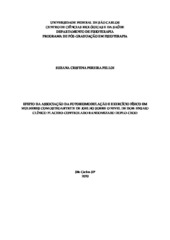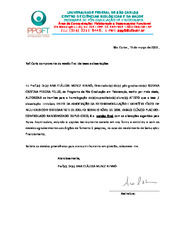| dc.contributor.author | Pelloi, Suzana Cristina Pereira | |
| dc.date.accessioned | 2020-06-18T12:22:51Z | |
| dc.date.available | 2020-06-18T12:22:51Z | |
| dc.date.issued | 2020-03-13 | |
| dc.identifier.citation | PELLOI, Suzana Cristina Pereira. Efeito da associação da fotobiomodulação e exercício físico em mulheres com osteoartrite de joelho sobre o nível de dor: ensaio clínico placebo-controlado randomizado duplo-cego. 2020. Dissertação (Mestrado em Fisioterapia) – Universidade Federal de São Carlos, São Carlos, 2020. Disponível em: https://repositorio.ufscar.br/handle/ufscar/12914. | * |
| dc.identifier.uri | https://repositorio.ufscar.br/handle/ufscar/12914 | |
| dc.description.abstract | OA is a degenerative disease with joint signs and symptoms associated with changes in the integrity of the articular cartilage, remodeling of the subchondral bones and local and adjacent tissue inflammation, clinically associated by joint pain and functional limitation. Pain is the biggest disabling factor, so it is important to investigate ways to improve it, and photobiomodulation (PBM) has been highlighted for promoting modulation of the inflammatory process and relief of pain of OA. The objective of this study was to verify whether the gradual increase in the dosage of FBM applied to the knee joint has more positive effects in the treatment of OA when combined with physical exercise, especially in relation to pain. Twenty-eight women, between 55 and 75 years old, with knee OA grades II and III, were allocated to the Physical Exercise Group associated with active PBM (PEAP), who received treatment with an eight-week exercise protocol associated with active irradiation of PBM and Physical Exercise Group associated with Placebo PBM (PEPP), which received the same treatment, but with placebo irradiation. PBM was performed with an 808nm laser, applied to the medial and lateral regions of the knee. The instruments used were (for assessment and reassessment) the Knee Injury and Osteoarthritis Outcome Score (KOOS) questionnaire, Visual Analogue Scale (VAS), digital algometer, Timed Up-and-Go Test (TUGT) and 6-minute walk test (6-MWT). The results obtained showed that there was an improvement in pain, symptoms and functionality in both groups, with no significant difference between them. It can be concluded that the exercise program was able to reduce the level of pain and increase the functional capacity of women affected by knee OA. However, the PBM used in the treatment regimen, with a progressive increase in the dose, did not optimize the positive results of the exercise program. | eng |
| dc.description.sponsorship | Não recebi financiamento | por |
| dc.language.iso | por | por |
| dc.publisher | Universidade Federal de São Carlos | por |
| dc.rights | Attribution-NonCommercial-NoDerivs 3.0 Brazil | * |
| dc.rights.uri | http://creativecommons.org/licenses/by-nc-nd/3.0/br/ | * |
| dc.subject | Osteoartrite | por |
| dc.subject | Fotobiomodulação | por |
| dc.subject | Exercício físico | por |
| dc.subject | Osteoarthritis | eng |
| dc.subject | Photobiomodulation | eng |
| dc.subject | Physical exercise | eng |
| dc.title | Efeito da associação da fotobiomodulação e exercício físico em mulheres com osteoartrite de joelho sobre o nível de dor: ensaio clínico placebo-controlado randomizado duplo-cego | por |
| dc.title.alternative | Effect of the association of photobiomodulation and physical exercise in women with knee osteoarthritis on the level of pain: double-blind randomized placebo-controlled clinical trial | eng |
| dc.type | Dissertação | por |
| dc.contributor.advisor1 | Renno, Ana Claudia Muniz | |
| dc.contributor.advisor1Lattes | http://lattes.cnpq.br/4106611304688552 | por |
| dc.description.resumo | A OA é uma doença degenerativa com sinais e sintomas articulares associados a alterações na integridade da cartilagem articular, remodelamento dos ossos subcondrais e inflamação local e de tecidos adjacentes, clinicamente acompanhada de dor articular e limitação funcional. A dor é o fator mais incapacitante. Assim, torna-se importante a investigação de meios que promovam sua melhora, e a fotobiomodulação (FBM) vem se destacando por promover modulação do processo inflamatório e alívio da dor da OA. O objetivo deste estudo foi verificar se o aumento gradual da dosagem na FBM aplicada na articulação do joelho traz mais efeitos positivos no tratamento da OA quando aliada ao exercício físico, principalmente em relação à dor. Foram avaliadas 28 mulheres, entre 55 e 75 anos, com OA de joelho graus II e III, alocadas em Grupo Exercício Físico associado à FBM ativa (EFFA), que receberam tratamento com protocolo de oito semanas de exercícios associado à irradiação ativa da FBM e Grupo Exercício Físico associado à FBM Placebo (EFFP), que receberam o mesmo tratamento, porém com irradiação placebo. A FBM foi realizada com laser 808nm, aplicada em região medial e lateral do joelho. Os instrumentos utilizados foram, para avaliação e reavaliação, o questionário Knee Injury and Osteoarthritis Outcome Score (KOOS), Escala Visual Analógica (EVA), algômetro digital, Teste Timed Up-and-Go (TTUG) e Teste de Caminhada de 6 minutos (TC-6). Os resultados obtidos mostraram que houve melhora da dor, sintomas e funcionalidade em ambos os grupos, sem diferença significativa entre eles. Assim, a partir dos resultados obtidos neste estudo, pode-se concluir que o programa de exercícios foi capaz de reduzir o nível de dor e aumentar a capacidade funcional das mulheres afetadas pela OA de joelho. No entanto, a FBM utilizado no regime de tratamento, com um aumento progressivo da dose, não otimizou os resultados positivos do programa de exercícios. | por |
| dc.publisher.initials | UFSCar | por |
| dc.publisher.program | Programa de Pós-Graduação em Fisioterapia - PPGFt | por |
| dc.subject.cnpq | CIENCIAS DA SAUDE::FISIOTERAPIA E TERAPIA OCUPACIONAL | por |
| dc.publisher.address | Câmpus São Carlos | por |
| dc.contributor.authorlattes | http://lattes.cnpq.br/5391906649812193 | por |


